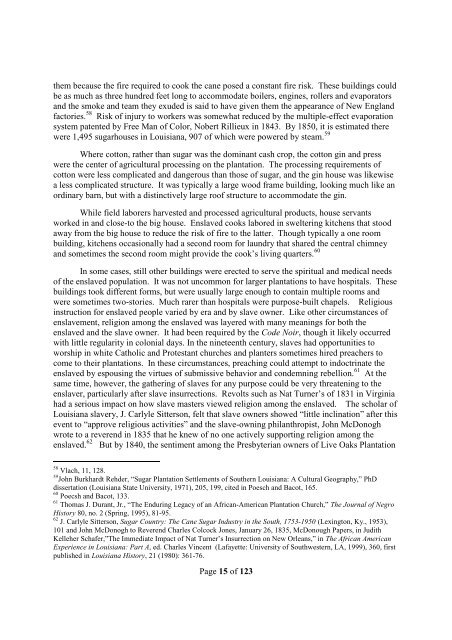The African American Experience in Louisiana
The_African_American_Experience_in_Louisiana
The_African_American_Experience_in_Louisiana
- No tags were found...
You also want an ePaper? Increase the reach of your titles
YUMPU automatically turns print PDFs into web optimized ePapers that Google loves.
them because the fire required to cook the cane posed a constant fire risk. <strong>The</strong>se build<strong>in</strong>gs could<br />
be as much as three hundred feet long to accommodate boilers, eng<strong>in</strong>es, rollers and evaporators<br />
and the smoke and team they exuded is said to have given them the appearance of New England<br />
factories. 58 Risk of <strong>in</strong>jury to workers was somewhat reduced by the multiple-effect evaporation<br />
system patented by Free Man of Color, Nobert Rillieux <strong>in</strong> 1843. By 1850, it is estimated there<br />
were 1,495 sugarhouses <strong>in</strong> <strong>Louisiana</strong>, 907 of which were powered by steam. 59<br />
Where cotton, rather than sugar was the dom<strong>in</strong>ant cash crop, the cotton g<strong>in</strong> and press<br />
were the center of agricultural process<strong>in</strong>g on the plantation. <strong>The</strong> process<strong>in</strong>g requirements of<br />
cotton were less complicated and dangerous than those of sugar, and the g<strong>in</strong> house was likewise<br />
a less complicated structure. It was typically a large wood frame build<strong>in</strong>g, look<strong>in</strong>g much like an<br />
ord<strong>in</strong>ary barn, but with a dist<strong>in</strong>ctively large roof structure to accommodate the g<strong>in</strong>.<br />
While field laborers harvested and processed agricultural products, house servants<br />
worked <strong>in</strong> and close-to the big house. Enslaved cooks labored <strong>in</strong> swelter<strong>in</strong>g kitchens that stood<br />
away from the big house to reduce the risk of fire to the latter. Though typically a one room<br />
build<strong>in</strong>g, kitchens occasionally had a second room for laundry that shared the central chimney<br />
and sometimes the second room might provide the cook’s liv<strong>in</strong>g quarters. 60<br />
In some cases, still other build<strong>in</strong>gs were erected to serve the spiritual and medical needs<br />
of the enslaved population. It was not uncommon for larger plantations to have hospitals. <strong>The</strong>se<br />
build<strong>in</strong>gs took different forms, but were usually large enough to conta<strong>in</strong> multiple rooms and<br />
were sometimes two-stories. Much rarer than hospitals were purpose-built chapels. Religious<br />
<strong>in</strong>struction for enslaved people varied by era and by slave owner. Like other circumstances of<br />
enslavement, religion among the enslaved was layered with many mean<strong>in</strong>gs for both the<br />
enslaved and the slave owner. It had been required by the Code Noir, though it likely occurred<br />
with little regularity <strong>in</strong> colonial days. In the n<strong>in</strong>eteenth century, slaves had opportunities to<br />
worship <strong>in</strong> white Catholic and Protestant churches and planters sometimes hired preachers to<br />
come to their plantations. In these circumstances, preach<strong>in</strong>g could attempt to <strong>in</strong>doctr<strong>in</strong>ate the<br />
enslaved by espous<strong>in</strong>g the virtues of submissive behavior and condemn<strong>in</strong>g rebellion. 61 At the<br />
same time, however, the gather<strong>in</strong>g of slaves for any purpose could be very threaten<strong>in</strong>g to the<br />
enslaver, particularly after slave <strong>in</strong>surrections. Revolts such as Nat Turner’s of 1831 <strong>in</strong> Virg<strong>in</strong>ia<br />
had a serious impact on how slave masters viewed religion among the enslaved. <strong>The</strong> scholar of<br />
<strong>Louisiana</strong> slavery, J. Carlyle Sitterson, felt that slave owners showed “little <strong>in</strong>cl<strong>in</strong>ation” after this<br />
event to “approve religious activities” and the slave-own<strong>in</strong>g philanthropist, John McDonogh<br />
wrote to a reverend <strong>in</strong> 1835 that he knew of no one actively support<strong>in</strong>g religion among the<br />
enslaved. 62 But by 1840, the sentiment among the Presbyterian owners of Live Oaks Plantation<br />
58 Vlach, 11, 128.<br />
59 John Burkhardt Rehder, “Sugar Plantation Settlements of Southern <strong>Louisiana</strong>: A Cultural Geography,” PhD<br />
dissertation (<strong>Louisiana</strong> State University, 1971), 205, 199, cited <strong>in</strong> Poesch and Bacot, 165.<br />
60 Poecsh and Bacot, 133.<br />
61 Thomas J. Durant, Jr., “<strong>The</strong> Endur<strong>in</strong>g Legacy of an <strong>African</strong>-<strong>American</strong> Plantation Church,” <strong>The</strong> Journal of Negro<br />
History 80, no. 2 (Spr<strong>in</strong>g, 1995), 81-95.<br />
62 J. Carlyle Sitterson, Sugar Country: <strong>The</strong> Cane Sugar Industry <strong>in</strong> the South, 1753-1950 (Lex<strong>in</strong>gton, Ky., 1953),<br />
101 and John McDonogh to Reverend Charles Colcock Jones, January 26, 1835, McDonough Papers, <strong>in</strong> Judith<br />
Kelleher Schafer,”<strong>The</strong> Immediate Impact of Nat Turner’s Insurrection on New Orleans,” <strong>in</strong> <strong>The</strong> <strong>African</strong> <strong>American</strong><br />
<strong>Experience</strong> <strong>in</strong> <strong>Louisiana</strong>: Part A, ed. Charles V<strong>in</strong>cent (Lafayette: University of Southwestern, LA, 1999), 360, first<br />
published <strong>in</strong> <strong>Louisiana</strong> History, 21 (1980): 361-76.<br />
Page 15 of 123


